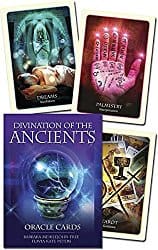
 Divination of the Ancients, by Barbara Meiklejohn-Free, Flavia Kate Peters, and Richard Crookes
Divination of the Ancients, by Barbara Meiklejohn-Free, Flavia Kate Peters, and Richard Crookes
Blue Angel Publishing, 9781922161925, 45 cards, 120 pp., 2016
Does a day ever go by without having to make choices and decisions? Not for me, and I’m rather certain not for you. We hope we’re making the right decisions; there may be no way to know until we see the outcome. Divination of the Ancients gives you the tools to have confidence that the decisions you make will bear fruit, or, tell you they might be the wrong ones so you can choose differently. The oracle cards depict age-old divinatory practices – astrology, I Ching, runes, and others — which, when used alone or in spreads, will assist you with choices great and small.
The authors include cards from three forms of divination, grouping them into three categories: Natural Divination (clouds, feathers, water, smoke, crystals), Interpreters (the I Ching, palmistry, astrology, handwriting, numerology), and Tools (books, cards, dice, lots, runes, pendulums).1 The kit itself is beautifully produced, as I’ve come to expect from Blue Angel Publishing decks: heavy card-stock, glossy and colourful artwork, sturdy box, and well-made guidebook. My only complaint, as always, is that the cards are too big2 for smaller hands to shuffle.
The guidebook contains an introduction, consisting of a guided visualization, a discussion of divination through the ages, and instructions on how to read the cards and form spreads. Next comes a section with messages for the 45 cards, with each message containing divinatory meanings, an incantation, and a short paragraph on the history of that form of divination and how it was used in ancient times. The amateur cultural anthropologist in me wishes the authors would have written more extensively of the tool’s significance over time; often this section is just two or three sentences long, not long enough to get a sense of that.
Most of the cards depict divinatory tools familiar to those in the occult community, and even in the wider community: astrology, numerology, crystal ball, palmistry. A few, though, seemed to me to be less well known as tools of divination — footprints, thunder and lightning — and there were a couple I’d never heard of: shagai and ogham.
Shagai, assigned the divinatory meaning of “fragmented,” originated and is still common in Mongolia and throughout central Asia, according to the authors. “Shagai refers to the collection of small knuckle bones of sheep, goats and, in some cases, wolves, which are thrown on the ground. The pattern they form is then divined by a bone thrower who is gifted in their interpretation.”3
Ogham, whose assigned divinatory meaning is “nature,” is never clearly explained, although the image is that of a tree and part of the message refers to trees.4 I did some research and found the ogham is a collection of markings that each denote one of the Druidic sacred trees, each of which has a meaning, so that the ogham forms a natural language of sorts. It would have been helpful if this crucial bit of information had made it into the card message!
One divinatory tool is downright whimsical — fortune cookies — until you read that “in the 13th and 14th centuries, still-popular moon cakes, forerunners of today’s fortune cookies, included messages by Ming revolutionaries meant to prompt the revolution to defeat the Mongols.”5 Who knew the lighthearted fortune cookie had started out so seriously?
I tried out the cards using one of the supplied queries: “I wish to have guidance about my finances.” I used the one-card spread, pulling tarot, meaning “guidance.” So far so good, since tarot is usually the first divinatory tool I turn to when I need guidance. Then I went a little more in depth using the Cornish Cross, a five-card spread. Each card I pulled seemed an appropriate answer for its position in the cross; together, they shed some helpful light on my particular situation.
Divination of the Ancients Oracle Cards is a solid deck, best suited to a beginning student of the occult who would like to get familiar with different divinatory practices. I recommend using the spreads to answer specific questions, but also using the cards to see if you are drawn to some particular divinatory tools. If so, consider going beyond the deck into deeper research and practice. Watching for signs and learning to interpret them is fundamental to occult practice and starting with this deck is as good a place as any.








